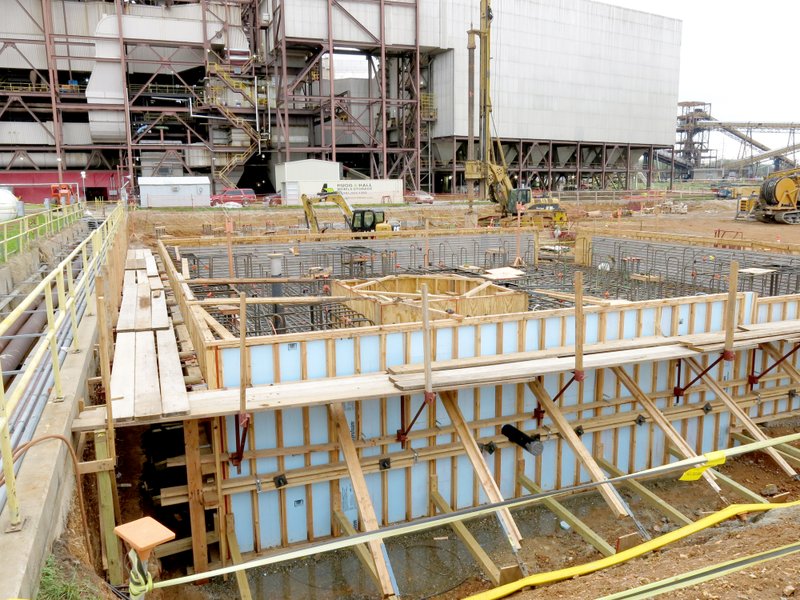GENTRY -- Work on the environmental controls retrofit project is well underway at Flint Creek Power Plant in Gentry, with new equipment to be operational by June 1, 2016.
Many footings had been poured and several forms were in place Thursday to pour concrete pads and foundations for the additions to the power plant structure.
What's being added to the plant? Alstom's NID flue gas desulfurization system, an air scrubbing system to comply with multiple new Environmental Protection Agency regulations going into effect next year. The plant was given a year's extension to comply while the system is being built.
In order to meet the new requirements, SWEPCO is installing controls for sulfur dioxide, mercury and other emissions. A dry flue gas desulfurization system, commonly known as a scrubber, reduces sulfur dioxide emissions. The system also includes a pulse jet fabric filter, commonly known as a baghouse, which physically traps and filters particulate matter. The system employs NID technology by Alstom. An activated carbon injection system reduces mercury emissions.
"What we like about the system is that it is simple and has few moving parts," said Carl Handley, manager of the power plant. The simplicity of the system is expected to make it easier to maintain and use.
Handley said Alstom's NID technology is being used at several other U.S. power plants, including NRG - Indian River Unit 4, Millsboro, Del.; Dominion - Brayton Point Unit 3, Somerset, Mass.; and Kiewit - Homer City Generating Station, Indiana County, Penn. He indicated the system was working well where it was online.
Also included in the project are a new lay-down yard on SWEPCO Road for delivery and storage of material and equipment -- it is already receiving deliveries of structural steel and other materials -- and a warehouse, which is complete, for use during construction and to support the scrubber when operations begin.
The civil general works contractor is Brasfield & Gorrie. Mechanical/structural and electrical contracts will be awarded in the next few months.
The plant's contractor work force is currently approximately 105 craft plus 35 management personnel but varies with the different stages of work, according to information released by Peter Main, SWEPCO's communications consultant. According to Main, the work force will range from 100 to 150 during 2014 and will rise "to around 320 peak in mid-2015."
Herb Nance, construction manager, is overseeing the day-to-day construction work on the project to ensure all is built to specifications. He explained the use of test footings to measure the load-bearing capacity of the footings currently being poured to support the foundation upon which the new system will rest.
Even with all the construction work and additional personnel on site, the plant employees and construction contractors have not had any lost-time accidents, Handley said, a fact which gives him and other plant personnel great satisfaction.
According to information released by Main, SWEPCO is installing equipment to comply with stringent new U.S. EPA regulations, which will allow the plant to continue providing reliable 24/7 baseload power for Northwest Arkansas.
He explained that with the one-year extension, the "compliance date is April 16, 2016, but the project will be in its "tie-in" outage in April and not operating until the end of May, 2016."
The Arkansas Public Service Commission ruled the project is in the public interest in July of 2013. Arkansas Department of Environmental Quality gave air-permit approval in October of 2013 (renewal of Title V permit plus modifications which allows construction and operation of new pollution control equipment to comply with new mercury and Air Toxics Standard). ADEQ granted a one-year extension from the federal April 2015 deadline to project compliance by April 2016.
General News on 04/30/2014

